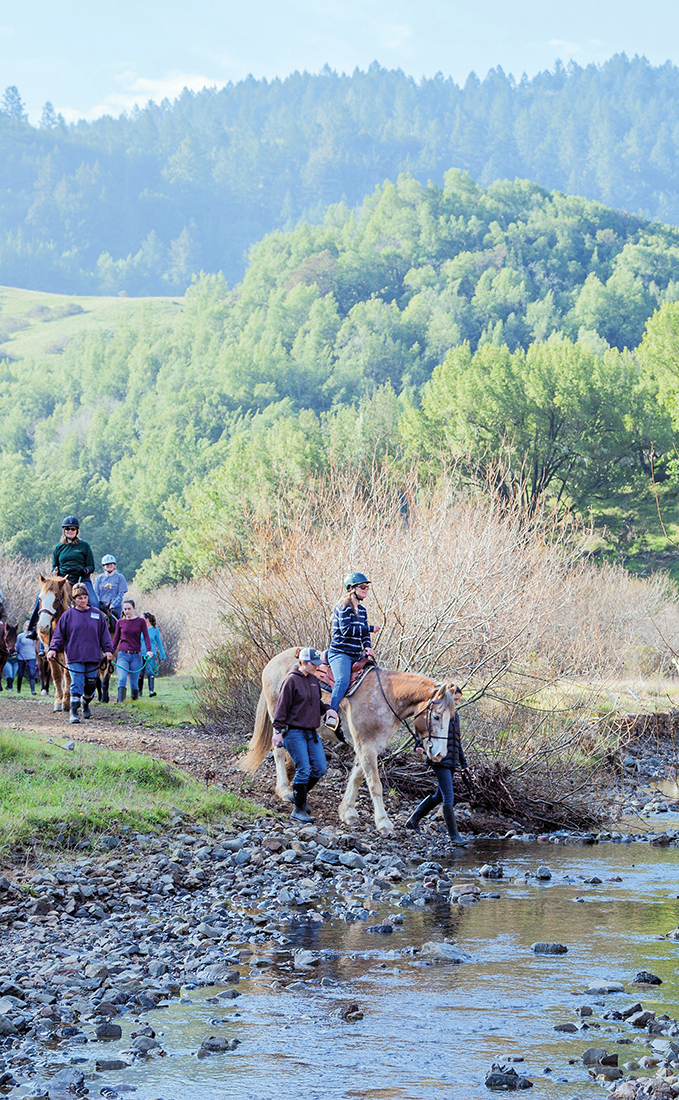Education
Nature
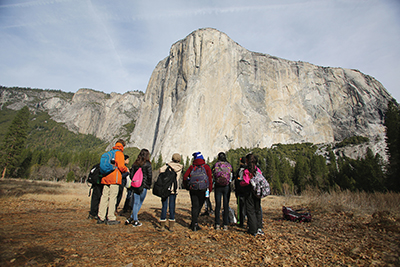
NatureBridge participants learn about stewardship on a trip to Yosemite.
Kids and adults are more disconnected from the outside world than ever before. Those behind the county’s nature education programs are trying to reverse the tide and ensure the world is being taken care of long into the future.
AUDUBON CANYON RANCH Education programs at the Audubon Canyon Ranch aim to connect children and adults with the natural world through hikes on its Tomales Bay and Martin Griffin preserves and classroom follow-up activities. Docent training programs and volunteer ranch and trail guides further support the group’s informational efforts. egret.org
NATUREBRIDGE This organization aims to teach environmental literacy for a sustainable future. NatureBridge offers school, group, family and youth programs focused on developing a strong sense of place in nature and creating interconnections that inspire stewardship. naturebridge.org
WILDCARE Inspired by famed Marin naturalist Elizabeth Terwilliger, who made it her life’s mission to foster appreciation of nature in children, WildCare has been delivering educational programs in the Bay Area for more than 35 years. Mrs. T, as her pupils called her, felt kids benefit most when they use all five senses, and she worked with local schools to create opportunities to learn about the natural world. Today WildCare offers nature camps, family adventures and other programs based on those original principles. wildcarebayarea.org
Art
Art programs being cut in favor of STEM (science, technology, engineering and math) subjects is leaving a void. Meanwhile, an overwhelming amount of evidence shows a correlation between art and other types of academic achievement, which the people behind these programs have recognized for a long time.
DRAWBRIDGE Operating in the belief that being understood and valued gives children freedom to grow, DrawBridge runs programs for homeless and at-risk children that let them imaginatively express themselves in a way they often can’t with words. Art therapy helps kids face complex emotional issues, provides an outlet for discussing difficult topics, and brings consistency and compassion to lives where there often isn’t much stability. drawbridge.org
HEADLANDS CENTER FOR THE ARTS Since 1982, the decommissioned military barracks at Fort Barry have provided space and support for more than 1,200 artists working in disciplines like painting, music, dance, writing and more. The studios give artists space to think and create free of distraction. Headlands programs include affiliate, artist-in-residence and various sponsored award opportunities — resulting in 22 Guggenheim Fellowships for participants thus far. headlands.org
YOUTH IN ARTS YIA is celebrating 45 years of helping children develop skills and the confidence to explore various facets of life through artist residencies, school events and other activities. The organization founded the Italian Street Painting Festival and was its sole producer for 16 years. Youth in Arts also runs the only student work gallery in the North Bay and serves more than 20,000 kids a year, including special education students. youthinarts.org
Special Needs
Everyone should have the chance to live as independently as possible, though some of our residents require more help to do that. These organizations support families, provide assistance, teach skills and strengthen the community by providing that boost.
ANOVA With autism diagnosis on the rise, the need for programs like Anova is critical. Its treatment model helps kids and teens address the social and emotional obstacles they face and teaches them to cope with these challenges in a way that alleviates many behavioral problems. Anova’s therapists are specially trained to handle concerns in all aspects of life, be it school, work or home, and provide comprehensive learning plans. anovaeducation.org
CEDARS OF MARIN One of California’s first programs for people with developmental disabilities, Cedars of Marin, began in 1919. The mix of residential care home, community-based homes, and day programs is designed to promote optimal life skills and work habits. Various activity plans, chosen to suit individual needs, include textile handcraft, nutrition and cooking, and even entrepreneurial projects. thecedarsofmarin.org
HALLECK CREEK RANCH Halleck Creek Ranch helps people with disabilities experience the therapeutic benefits of horseback riding. Many riders have felt a sense of freedom and mobility, which according to the therapists “allows them to imagine a future and enjoy the present. The relationships between riders, volunteers and horses establish connections that benefit our entire community.” halleckcreekranch.org
LIFEHOUSE “It’s just different” is a message you’ll hear echoed by parents and facilitators at Lifehouse. The organization offers services to help people deal with developmental disabilities but, just as important, it creates an inclusive community that battles ignorance and promotes understanding. The program is committed to ensuring people have a good life and equipping them with the skills to make it possible. lifehouseagency.org
MARIN CENTER FOR INDEPENDENT LIVING Since 1979, Marin Center for Independent Living has worked to allow people with disabilities to remain in their homes and in the community. MCIL offers more than a dozen programs to help people cope with difficult living situations including skills training, benefits planning (including breast cancer benefits planning and assistance), home modifications and housing assistance. marincil.org
Community
Older Adults
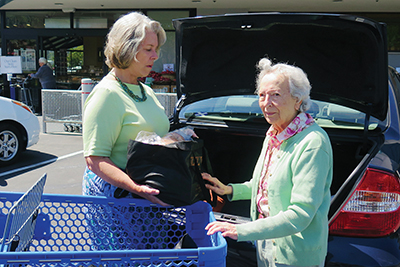
Whistlestop participant receiving assistance from volunteer.
According to data collected in 2011, Marin County has the highest personal wealth per capita in California, yet nearly a quarter of the county’s seniors are living in poverty. The vast spaces we cherish create a disadvantage in that respect, as this growing population is often unseen and deals with transportation issues on top of health concerns.
INSTITUTE ON AGING Started in 1975 at UCSF Mount Zion Hospital as an alternative to a nursing home, the Institute on Aging is the first adult day health center in a U.S. community hospital. Since inception it has instigated several firsts, including a creative arts initiative for homebound seniors, and specializes in helping those who can’t join other programs due to issues like dementia. The institute also offers outpatient services to limit hospitalizations for frail elders. ioaging.org
SENIOR ACCESS All the research coming out of the Buck Institute points to the prevalence of Alzheimer’s disease in our community and beyond. The Club at Senior Access provides stimulating art and music programs, group exercises, brain games and nutritional services to help Marin seniors combat memory loss. Excursions are available for those with early-stage impairment, along with caregiver support and educational workshops. senioraccess.org
WHISTLESTOP Whistlestop began as a grassroots organization seeking to improve quality of life for older adults and those with disabilities. With comprehensive programs that include specialized transportation and affordable meals, it promotes independence and well-being. Currently, Whistlestop provides upwards of 145,000 rides a year to a community that faces isolation, especially if a spouse passes. whistlestop.org
At Risk
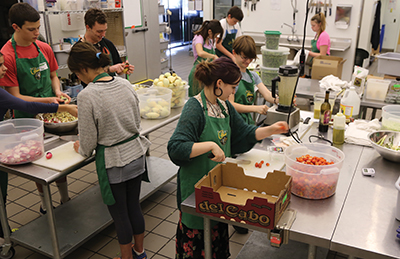
Teens learn cooking skills at Ceres Community Project, which will benefit those in need of healthy food
A count of Marin County’s homeless population in January 2015 found 1,309 people without a home, a 40 percent increase from 2013. Here are local resources for the homeless and vulnerable:
ADOPT A FAMILY Adopt A Family helps more than 500 families each year attain stability and prevent homelessness. It offers comprehensive assessment of individual needs, financial aid, case management and emotional support that includes setting self-sufficiency goals, along with rapid rehousing and emergency contingency funding for families 200 percent below the poverty level. adoptafamily.org
HOMEWARD BOUND Homeward Bound focuses on finding permanent living solutions for adults, families and people with mental health issues; every year about 10 percent of clients are veterans of war. Additionally, its Fresh Starts Culinary Academy provides food service industry training that encompasses culinary and life skills, interview techniques, resume writing and job search help. hbofm.org
RITTER CENTER The Ritter Center has been helping homeless and low-income residents in Marin meet various needs for more than 30 years. Participants are offered everything from primary health care and housing to clothing and employment services. Case plans are developed to help stabilize clients and provide a boost toward self-sufficiency. rittercenter.org
SUNNY HILLS Originally founded as an orphanage near the turn of the century, this organization believes that all children should have the resources, support and skills to develop into healthy adults. Each year more than 1,600 young people and another 1,100 members of their families are helped by Sunny Hills through programs that focus on the educational, mental health, housing and developmental needs of vulnerable youth. sunnyhillsservices.org
WARM WISHES Bill Hamm was inspired to found Warm Wishes after giving a pair of gloves to a homeless man more than 20 years ago. A part of MarinLink, Warm Wishes takes a hands-on approach during the winter holiday season by distributing packs of supplies to keep people who live on the street warm and dry. warmwishes.org
Nutrition
Jimmy Carter is famously quoted as saying the measure of a society is found in how it treats its most vulnerable — and we can all agree a hungry population is one that is not being well cared for. Fortunately for those needing food, the county has several groups offering help.
EXTRAFOOD More than 40,000 of Marin’s citizens don’t have a secure food supply. ExtraFood works by connecting businesses that can offer at least 10 servings of food with volunteers, who pick up and deliver the food within half an hour. Volunteers range from high school students to adults and include public relations and grant-writing specialists. The program also helps reduce methane emissions by reducing food waste. extrafood.org
MARIN CERES COMMUNITY PROJECT Ceres is founded on the core principles that food is medicine, teens can be empowered to create healthy meals, and community education can promote good eating practices. Having just celebrated its fifth year, the program continues its mission of teaching young people to prepare nutritious food and delivering it to people with debilitating illnesses. Fresh food reduces long-term health costs and the deliveries alleviate loneliness, ensuring people don’t fall through the cracks. marin.ceresproject.org
SF–MARIN FOOD BANK Although the ’08 recession may seem a distant memory, its lingering effects, coupled with cuts in government funding, are felt by many. Fortunately, programs like the food bank assist those in need. The Marin branch has strengthened considerably ever since it merged with its San Francisco counterpart in 2011, and last year it helped distribute more than five million pounds of food, the equivalent of 12,000 meals a day. sfmfoodbank.org
Environment
Land
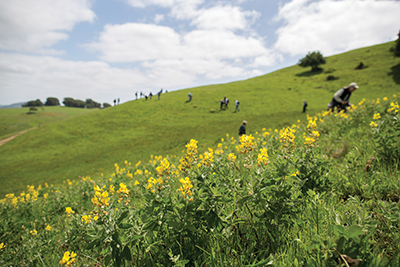
Citizen scientists identify wildflowers at Leiss Ranch for MALT.
“It’s so beautiful there,” people often say of Marin, and it’s true. With all the farms and open space, the land here is more than something to post on Instragram.
MARIN AGRICULTURAL LAND TRUST MALT has been helping families hold on to their farms for more than 30 years, but its programs extend much further. In a recent partnership with the California Academy of Sciences, it arranged a “bioblitz” wherein people went out to Millerton Creek Ranch as citizen-scientists to document animals and plants. Signature events like the Tour de MALT barn-to-barn cycling fundraiser also help promote its causes. malt.org
MARIN CONSERVATION LEAGUE One of the most esteemed environmental organizations in Marin, the league has made it its mission to not only protect but enhance nature for people to enjoy. Its scope includes studying and analyzing issues, crafting environmental policies, and acquiring and conserving land. Through these efforts the league hopes to mobilize citizens and create policies that benefit our surroundings. marinconservationleague.org
MARIN OPEN LAND TRUST Marin Open Space Trust has helped save more than 15,000 acres of open space in Marin. It works with other conservation groups to support parks and undeveloped land, believing they have value for both human and nonhuman residents. Recently, it purchased Sky Ranch, a 16-acre parcel it will restore for public use. marinopenspacetrust.org
Waterways
California’s historic drought is casting light on many factors influencing our drinking water supply — including the actions of humans. No matter where you live in the county, your day-today behavior affects watersheds and creeks because, here in Marin, all storm drains flow directly to local creeks, bays or the ocean without treatment.
GALLINAS WATERSHED COUNCIL The Gallinas Watershed Council attempts to give people who live and spend time in the valley a sense of connection to the creek and watershed. Through local conservation, protection and education, restoration is possible and could result in salmon returning to the area to spawn like they have in the past. The watershed is currently facing stressors like the San Rafael airport expansion as well as trash. gallinaswatershed.org
TOMALES BAY WATERSHED COUNCIL Formed in 1999 in response to concerns about water quality, the Tomales Bay Watershed Council works to monitor, protect and restore the waters and lands of the area. Some of its other efforts involve enhancing riparian corridors, increasing reliability of water supplies and promoting stewardship. Many problems endanger the watershed, including septic pollution and storm water damage. The council aims to reverse these issues. tomalesbaywatershed.org
TURTLE ISLAND RESTORATION NETWORK Basing its work on scientific principles, the Turtle Island Restoration Network advocates for the world’s oceans and marine wildlife. It works with communities to promote sustainable marine policies and raise awareness about biodiversity on land and in oceans. Programs include naturalist training and salmon and other wildlife protection. seaturtles.org
Animals
Marin has a very high level of biodiversity, with more than 490 species of birds observed in the county. Wild or domesticated, land or sea dwelling — these organizations have them all covered.
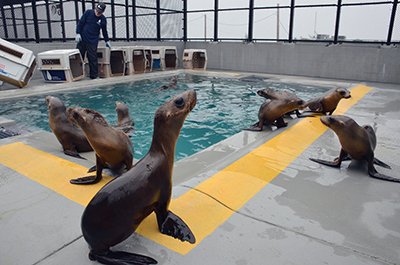
California sea lions ready for release at the Marine Mammal Center.
HUNGRY OWL PROJECT This education and rehab center began in partnership with WildCare in 2001, aiming to address the increase in owls, hawks and other raptors testing positive for toxic rodenticides. The project attempts to reduce use of these substances, which cause slow and painful deaths; operates programs like Raptor Rescue and Reunite; and has installed owl-cams to instill respect for the majestic creatures. hungryowl.org
MARINE MAMMAL CENTER This veterinary research hospital and educational center is dedicated to the rescue and rehabilitation of sick and injured creatures. Headquartered in Sausalito, it has rescued and cared for more than 20,000 animals, and its new research facility should boost those impressive numbers even more. The center also promotes study of mammalian illnesses like cancer, found in 17 percent of adult sea lions at the hospital. marinemammalcenter.org
MARIN HUMANE SOCIETY The Marin Humane Society started in San Anselmo in 1907 to improve the lives of animals and people through advocacy, education and support. Since then, it has been a leader in animal welfare, expanding efforts to save more animals, and raising awareness through signature events like Catapalooza and Woofstock. The organization offers training courses, workshops and information on topics ranging from animal care in a natural disaster to concerns about feral cats. marinhumanesociety.org
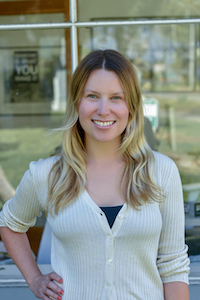
Kasia Pawlowska loves words. A native of Poland, Kasia moved to the States when she was seven. The San Francisco State University creative writing graduate went on to write for publications like the San Francisco Bay Guardian and KQED Arts among others prior to joining the Marin Magazine staff. Topics Kasia has covered include travel, trends, mushroom hunting, an award-winning series on social media addiction and loads of other random things. When she’s not busy blogging or researching and writing articles, she’s either at home writing postcards and reading or going to shows. Recently, Kasia has been trying to branch out and diversify, ie: use different emojis. Her quest for the perfect chip is never-ending.

